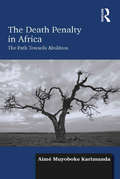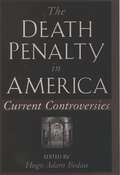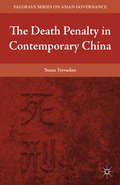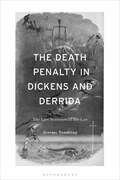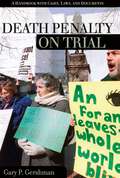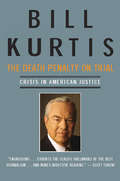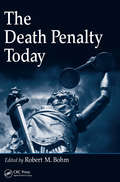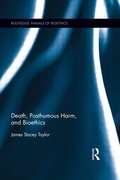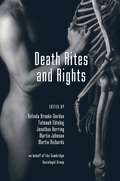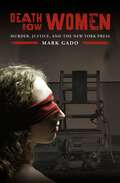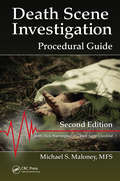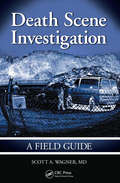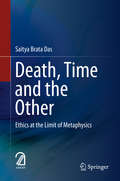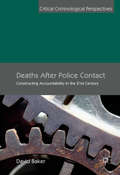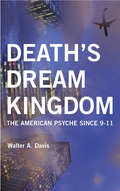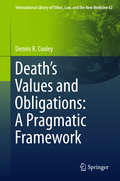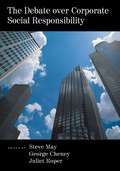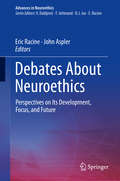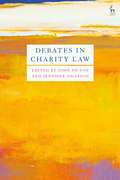- Table View
- List View
The Death Penalty in Africa: The Path Towards Abolition
by Aimé Muyoboke KarimundaHuman development is not simply about wealth and economic well-being, it is also dependent upon shared values that cherish the sanctity of human life. Using comparative methods, archival research and quantitative findings, this book explores the historical and cultural background of the death penalty in Africa, analysing the law and practice of the death penalty under European and Asian laws in Africa before independence. Showing progressive attitudes to punishment rooted in both traditional and modern concepts of human dignity, Aimé Muyoboke Karimunda assesses the ground on which the death penalty is retained today. Providing a full and balanced appraisal of the arguments, the book presents a clear and compelling case for the total abolition of the death penalty throughout Africa. This book is essential reading for human rights lawyers, legal anthropologists, historians, political analysts and anyone else interested in promoting democracy and the protection of fundamental human rights in Africa.
The Death Penalty in America
by Hugo Adam BedauInThe Death Penalty in America: Current Controversies, Hugo Adam Bedau, one of our preeminent scholars on the subject,provides a comprehensive sourcebook on the death penalty, making the process of informed consideration not only possible but fascinating as well. No mere revision of the third edition of The Death Penalty in America--which the New York Times praised as "the most complete, well-edited and comprehensive collection of readings on the pros and cons of the death penalty"--this volume brings together an entirely new selection of 40 essays and includes updated statistical and research data, recent Supreme Court decisions, and the best current contributions to the debate over capital punishment. From the status of the death penalty worldwide to current attitudes of Americans toward convicted killers, from legal arguments challenging the constitutionality of the death penalty to moral arguments enlisting the New Testament in support of it, from controversies over the role of race and class in the judicial system to proposals to televise executions, Bedau gathers readings that explore all the most compelling aspects of this most compelling issue.
The Death Penalty in Contemporary China (Palgrave Series in Asian Governance)
by S. TrevaskesChina's infamous death penalty record is the product of firm Party-state control and policy-setting. Though during the 1980s and 1990s, the Party's emphasis was on "kill many," in the 2000s the direction of policy began to move toward "kill fewer." This book details the policies, institutions, and story behind the reform of the death penalty.
The Death Penalty in Dickens and Derrida: The Last Sentence of the Law
by Jeremy TamblingIn the nineteenth century, Charles Dickens backed the cause of abolition of the death penalty and wrote comprehensively about it, in public letters and in his novels. At the end of the twentieth century, Jacques Derrida ran two years of seminars on the subject, which were published posthumously. What the novelist and the philosopher of deconstruction discussed independently, this book brings into comparison.Tambling examines crime and punishment in Dickens's novels Barnaby Rudge, A Tale of Two Cities, Oliver Twist and Bleak House and explores those who influenced Dickens's work, including Hogarth, Fielding, Godwin and Edgar Allen Poe. This book also looks at those who influenced Derrida – Freud, Nietzsche, Foucault and Blanchot – and considers Derrida's study on terrorism and the USA as the only major democracy adhering to the death penalty.A comprehensive study of punishment in Dickens, and furthering Derrida's insights by commenting on Shakespeare and blood, revenge, the French Revolution, and the enduring power of violence and its fascination, this book is a major contribution to literary criticism on Dickens and Derrida. Those interested in literature, criminology, law, gender, and psychoanalysis will find it an essential intervention in a topic still rousing intense argument.
Death Penalty on Trial: A Handbook with Cases, Laws, and Documents (On Trial)
by Gary P. GershmanAn extensive survey of the pros and cons, evolution, and current issues surrounding one of the hottest topics in today's social debates.Death Penalty on Trial: A Handbook with Cases, Laws, and Documents sifts through the rhetoric, politics, and emotion that characterize one of the most highly discussed, yet least understood issues facing the United States today. Placing the death penalty in a historical perspective with an emphasis on the last 50 years, this case-driven volume explains the legal theory that has perpetuated it and the judicial reasoning, both pro and con, behind such landmark Supreme Court cases as Furman v. Georgia and The United States of America v. Alan Quinones.From the first Massachusetts Bay Colony execution and the inventions of the electric chair and gas chamber to DNA testing of inmates, readers will learn how and why capital punishment continues to be so controversial.
Death Penalty on Trial: Crisis in American Justice
by Bill KurtisBill Kurtis, anchor of the wildly popular true-crime TV series Cold Case Files and American Justice, used to support the death penalty. But after observing the machinations of the justice system for thirty years, he came to a stunning realization that changed his life: Capital punishment is wrong. There can be no real justice in America until it is abolished. In The Death Penalty on Trial, Kurtis takes readers on his most remarkable investigative journey yet. Together, we revisit murder scenes, study the evidence, and explore the tactical decisions made before and during trials that send innocent people to death row. We examine the eight main reasons why the wrong people are condemned to death, including overzealous and dishonest prosecutors, corrupt policemen, unreliable witnesses and expert witnesses, incompetent defense attorneys, bias judges, and jailhouse informants. We see why the new jewel of forensic science, DNA, is revealing more than innocence and guilt, opening a window into the criminal justice system that could touch off a revolution of reform. Ultimately we come to a remarkable conclusion: The possibility for error in our justice system is simply too great to allow the death penalty to stand as our ultimate punishment.
Death Penalty on Trial: Crisis in American Justice
by Bill KurtisBill Kurtis, anchor of the wildly popular true-crime TV series Cold Case Files and American Justice, used to support the death penalty. But after observing the machinations of the justice system for thirty years, he came to a stunning realization that changed his life: Capital punishment is wrong. There can be no real justice in America until it is abolished. In The Death Penalty on Trial, Kurtis takes readers on his most remarkable investigative journey yet. Together, we revisit murder scenes, study the evidence, and explore the tactical decisions made before and during trials that send innocent people to death row. We examine the eight main reasons why the wrong people are condemned to death, including overzealous and dishonest prosecutors, corrupt policemen, unreliable witnesses and expert witnesses, incompetent defense attorneys, bias judges, and jailhouse informants. We see why the new jewel of forensic science, DNA, is revealing more than innocence and guilt, opening a window into the criminal justice system that could touch off a revolution of reform. Ultimately we come to a remarkable conclusion: The possibility for error in our justice system is simply too great to allow the death penalty to stand as our ultimate punishment.
The Death Penalty Today
by Robert M. BohmMore than 30 years after the US Supreme Court reinstated the death penalty, it is still plagued with egregious problems. Issues of wrongful conviction, inhumane practices, and its efficacy as a deterrent are hotly debated topics. As of August 2007, two-thirds of the world�s countries have abolished the death penalty. Today, the US falls alongside I
Death, Posthumous Harm, And Bioethics
by James Stacey TaylorDeath, Posthumous Harm, and Bioethics offers a highly distinctive and original approach to the metaphysics of death and applies this approach to contemporary debates in bioethics that address end-of-life and post-mortem issues. Taylor defends the controversial Epicurean view that death is not a harm to the person who dies and the neo-Epicurean thesis that persons cannot be affected by events that occur after their deaths, and hence that posthumous harms (and benefits) are impossible. He then extends this argument by asserting that the dead cannot be wronged, finally presenting a defence of revisionary views concerning posthumous organ procurement.
Death, Posthumous Harm, And Bioethics (PDF)
by James Stacey TaylorDeath, Posthumous Harm, and Bioethics offers a highly distinctive and original approach to the metaphysics of death and applies this approach to contemporary debates in bioethics that address end-of-life and post-mortem issues. Taylor defends the controversial Epicurean view that death is not a harm to the person who dies and the neo-Epicurean thesis that persons cannot be affected by events that occur after their deaths, and hence that posthumous harms (and benefits) are impossible. He then extends this argument by asserting that the dead cannot be wronged, finally presenting a defence of revisionary views concerning posthumous organ procurement.
Death Rites and Rights
by Belinda Brooks-Gordon Fatemeh Ebtehaj Jonathan Herring Martin Johnson M.A., PhD., F.R.C.O.G. Martin RichardsDeath has diverse religious, social, legal, and medical aspects and is one of the main areas in which medicine and the law intersect. In this volume, we ask: What is the meaning of death in contemporary Britain, and in other cultures, and how has it changed over time? The essays in this collection tackle the diverse ways in which death is now experienced in modern society, in the process answering a wide variety of questions: How is death defined by law? Do the dead have legal rights? What is one allowed to have and not have done to one's body after death? What are the rights of next of kin in this respect? What compensation exists for death and how is death valued? What is happening to the law on euthanasia and suicide? Is there a human right to die? What is the principle of sanctity of life? What of criminal offences against the dead? How are the traditions of death still played out in religion? How have customs and traditions of the disposal of bodies and funerals changed? What happens to donated bodies in the biomedical setting where anatomical education is permitted? What processes are employed by police when investigating suspicious deaths? What of representations of death? These and other questions are the subject of this challenging and diverse set of essays.
Death Row Women: Murder, Justice, and the New York Press (Crime, Media, and Popular Culture)
by Mark GadoDuring the 20th century, only six women were legally executed by the State of New York at Sing Sing Prison. In each case, the condemned faced a process of demonization and public humiliation that was orchestrated by a powerful and unforgiving media. When compared to the media treatment of men who went to the electric chair for similar offenses, the press coverage of female killers was ferocious and unrelenting. Granite woman, black-eyed Borgia, roadhouse tramp, sex-mad, and lousy prostitute are just some of the terms used by newspapers to describe these women. Unlike their male counterparts, females endured a campaign of expulsion and disgrace before they were put to death. Not since the 1950s has New York put another woman to death.Gado chronicles the crimes, the times, and the media attention surrounding these cases. The tales of these death row women shed light on the death penalty as it applies to women and the role of the media in both the trials and executions of these convicts. In these cases, the press affected the prosecutions, the judgements, and the decisions of authorities along the way. Contemporary headlines of the era are revealing in their blatant bias and leave little doubt of their purpose. Using family letters, prison correspondence, photographs, court transcripts, and last- minute pleas for mercy, Gado paints a fuller picture of these cases and the times.
Death Scene Investigation: Procedural Guide, Second Edition
by Michael S. MaloneyThose tasked with investigating death scenes come from a variety of backgrounds and varying levels of experience. Whether a homicide detective, crime scene investigator, medico-legal death investigator, coroner or medical examiner, Death Scene Investigation: Procedural Guide, Second Edition provides the investigator best-practice techniques and procedures for almost any death scene imaginable, including for deaths occurring even under the most unusual of circumstances. This Second Edition is fully updated to include new coverage on shallow graves, human remains at crime scenes, poisonings, expanded coverage of projectile weapons, videography, touch DNA, death notifications, and a newly added chapter dedicated to sexual deaths. In addition, the book serves as an on-scene ready reference which includes instructions on procedure including the initial notification of a death, processing the scene and body, the investigator's role at autopsy, and analyzing the scene indicators to place evidence into context. Topics discussed include: Initial response and scene evaluation Death scene management including documentation, sketching, photography, videography, observations, and search procedures A special death investigation matrix that walks the investigator though a decision tree to help in ambiguous deaths Contains discussion of all manners of death, including accident, suicide, natural and homicide Coverage of recovery of human remains from open field, aquatic, and buried sites including estimating the time of death. Wound dynamics and mechanisms of injury that covers asphyxiation, sharp and blunt force trauma, chopping injuries; handgun, rifle, and shotgun wounds, electrical injuries, and more The bulleted format and spiral binding allows for easy use and reference in the field with sections that are self-contained and cross-referenced for quick searches. With its thorough and detailed approach, Death Scene Investigation, Second Edition will be a must-have addition to any crime scene and death investigator’s tool kit.
Death Scene Investigation: Procedural Guide, Second Edition
by Michael S. MaloneyThose tasked with investigating death scenes come from a variety of backgrounds and varying levels of experience. Whether a homicide detective, crime scene investigator, medico-legal death investigator, coroner or medical examiner, Death Scene Investigation: Procedural Guide, Second Edition provides the investigator best-practice techniques and procedures for almost any death scene imaginable, including for deaths occurring even under the most unusual of circumstances. This Second Edition is fully updated to include new coverage on shallow graves, human remains at crime scenes, poisonings, expanded coverage of projectile weapons, videography, touch DNA, death notifications, and a newly added chapter dedicated to sexual deaths. In addition, the book serves as an on-scene ready reference which includes instructions on procedure including the initial notification of a death, processing the scene and body, the investigator's role at autopsy, and analyzing the scene indicators to place evidence into context. Topics discussed include: Initial response and scene evaluation Death scene management including documentation, sketching, photography, videography, observations, and search procedures A special death investigation matrix that walks the investigator though a decision tree to help in ambiguous deaths Contains discussion of all manners of death, including accident, suicide, natural and homicide Coverage of recovery of human remains from open field, aquatic, and buried sites including estimating the time of death. Wound dynamics and mechanisms of injury that covers asphyxiation, sharp and blunt force trauma, chopping injuries; handgun, rifle, and shotgun wounds, electrical injuries, and more The bulleted format and spiral binding allows for easy use and reference in the field with sections that are self-contained and cross-referenced for quick searches. With its thorough and detailed approach, Death Scene Investigation, Second Edition will be a must-have addition to any crime scene and death investigator’s tool kit.
Death Scene Investigation: A Field Guide
by Scott A. WagnerEach and every death scene presents new challenges to even the most seasoned investigator. Despite the unique nature of each scenario, using a standardized protocol is the key to ensuring consistent and accurate results. Death Scene Investigation: A Field Guide provides concise direction for the death scene investigator, crime scene investigator, c
Death, Time and the Other: Ethics at the Limit of Metaphysics
by Saitya Brata DasThis book addresses the limits of metaphysics and the question of the possibility of ethics in this context. It is divided into six chapters, the first of which broadens readers’ understanding of difference as difference with specific reference to the works of Hegel. The second chapter discusses the works of Emmanuel Lévinas and the question of the ethical. In turn, the concepts of sovereignty and the eternal return are discussed in chapters three and four, while chapter five poses the question of literature in a new way. The book concludes with chapter six. The book represents an important contribution to the field of contemporary philosophical debates on the possibility of ethics beyond all possible metaphysical and political closures. As such, it will be of interest to scholars and researchers in both the humanities and social sciences. Beyond the academic world, the book will also appeal to readers (journalists, intellectuals, social activists, etc.) for whom the question of the ethical is the decisive question of our time.
Deaths After Police Contact: Constructing Accountability in the 21st Century (Critical Criminological Perspectives)
by David BakerThis book investigates death after police contact in England and Wales in the twenty-first century. It examines how regulatory bodies construct accountability in such cases. Cases of death after police contact have the potential to cause deep unease in society. They highlight the unique role of the police in being legitimately able to use force whilst at the same time being expected to preserve life. People who are from Black, or Minority Ethnic backgrounds, or have mental health issues, or are dependent on substances are disproportionately more likely to die in these cases, and this emphasises the sensitive nature of many of these deaths to society.Deaths after Police Contact examines police legitimacy and the legitimacy of police regulators in these cases. The book argues that accountability is produced by a relatively arbitrary system of regulation that investigates such deaths as individual cases, rather than attempting to learn lessons from annual trends and patterns that might prevent future deaths. It will be of great interest to scholars and upper-level students of policing and criminal justice.
Death's Dream Kingdom: The American Psyche Since 9-11
by Walter A. DavisWhy is fear a dominant emotion in contemporary society? Why are politicians using words like 'terror', 'evil' and 'fundamentalism', and what effect is it having on public consciousness?*BR**BR*This book taps into the cultural psyche to explore the link between ideology and emotional and psychological manipulation. It shows that the Bush administration has been hugely successful in controlling and developing a new political climate through the creation of an almost hypnotic mass consciousness. *BR**BR*From the sado-masochist hysteria of Mel Gibson's The Passion of the Christ‚ to the atrocities at Abu Ghraib prison; and from the genocidal use of depleted uranium in Iraq to the apocalyptic language driving the Christian Right's assault on basic human rights.*BR**BR*Davis's findings take us to the heart of the ideological paralysis of the Left, while offering an innovative approach to understanding contemporary history.
Death’s Values and Obligations: A Pragmatic Framework (International Library of Ethics, Law, and the New Medicine #62)
by Dennis R. CooleyThis book brings together the relevant interdisciplinary and method elements needed to form a conceptual framework that is both pragmatic and rigorous. By using the best and often the latest, work in thanatology, psychology, neuroscience, sociology, physics, philosophy and ethics, it develops a framework for understanding both what death is – which requires a great deal of time spent developing definitions of the various types of identity-in-the-moment and identity-over-time – and the values involved in death. This pragmatic framework answers questions about why death is a form of loss; why we experience the emotional reactions, feelings and desires that we do; which of these reactions, feelings and desires are justified and which are not; if we can survive death and how; whether our deaths can harm us; and why and how we should prepare for death. Thanks to the pragmatic framework employed, the answers to the various questions are more likely to be accurate and acceptable than those with less rigorous scholarly underpinnings or which deal with utopian worlds.
The Debate over Corporate Social Responsibility
by George Cheney Steve May Juliet RoperShould business strive to be socially responsible, and if so, how? The Debate over Corporate Social Responsibility updates and broadens the discussion of these questions by bringing together in one volume a variety of practical and theoretical perspectives on corporate social responsibility. It is perhaps the single most comprehensive volume available on the question of just how "social" business ought to be. The volume includes contributions from the fields of communication, business, law, sociology, political science, economics, accounting, and environmental studies. Moreover, it draws from experiences and examples from around the world, including but not limited to recent corporate scandals and controversies in the U.S. and Europe. A number of the chapters examine closely the basic assumptions underlying the philosophy of socially responsible business. Other chapters speak to the practical challenges and possibilities for corporate social responsiblilty in the twenty-first century. One of the most distinctive features of the book is its coverage of the very ways that the issue of corporate social responsibility has been defined, shaped, and discussed in the past four decades. That is, the editors and many of the authors are attuned to the persuasive strategies and formulations used to talk about socially responsible business, and demonstrate why the talk matters. For example, the book offers a careful analysis of how certain values have become associated with the business enterprise and how particular economic and political positions have been established by and for business. This book will be of great interest to scholars, business leaders, graduate students, and others interested in the contours of the debate over what role large-scale corporate commerce should take in the future of the industrialized world.
The Debate over Corporate Social Responsibility
by Steven K. May George Cheney Juliet RoperShould business strive to be socially responsible, and if so, how? The Debate over Corporate Social Responsibility updates and broadens the discussion of these questions by bringing together in one volume a variety of practical and theoretical perspectives on corporate social responsibility. It is perhaps the single most comprehensive volume available on the question of just how "social" business ought to be. The volume includes contributions from the fields of communication, business, law, sociology, political science, economics, accounting, and environmental studies. Moreover, it draws from experiences and examples from around the world, including but not limited to recent corporate scandals and controversies in the U.S. and Europe. A number of the chapters examine closely the basic assumptions underlying the philosophy of socially responsible business. Other chapters speak to the practical challenges and possibilities for corporate social responsiblilty in the twenty-first century. One of the most distinctive features of the book is its coverage of the very ways that the issue of corporate social responsibility has been defined, shaped, and discussed in the past four decades. That is, the editors and many of the authors are attuned to the persuasive strategies and formulations used to talk about socially responsible business, and demonstrate why the talk matters. For example, the book offers a careful analysis of how certain values have become associated with the business enterprise and how particular economic and political positions have been established by and for business. This book will be of great interest to scholars, business leaders, graduate students, and others interested in the contours of the debate over what role large-scale corporate commerce should take in the future of the industrialized world.
Debates About Neuroethics: Perspectives on Its Development, Focus, and Future (Advances in Neuroethics)
by Eric Racine John AsplerThis is the first book entirely dedicated to exploring issues associated with the nature of neuroethics. It reflects on some of the underlying assumptions in neuroethics, and the implications of those assumptions with respect to training and education programs, research activities, policy engagement, public discourse, teaching, ethics consultation and mentoring, to name but a few areas of interest. Internationally respected and emerging leaders in the area have taken up the pen to express and debate their views about the development, focus and future of neuroethics. They share their analyses and make recommendations regarding how neuroscience could more effectively explore and tackle its philosophical, ethical, and societal implications.
Debates in Charity Law
by John Picton Jennifer SigafoosCharitable organisations occupy a central place in society across much of the world, accounting for billions of pounds in revenue. As society changes, so does the law which regulates nonprofit organisations. From independent schools to foodbanks, they occupy a broad policy space. Not immune to scandals, sometimes nonprofits are in the news for all the wrong reasons and so, when they are in the public eye, regulators must respond to high profile cases. In this book, a team of internationally recognised charity law experts offers a modern take on a fast-changing policy field. Through the concept of policy debates it moves the field forward, providing an important reference point for developing scholarship in charity law and policy. Each chapter explores a policy debate, setting out the fault-lines in play, and often offering proposals for reform.Two important themes are explored in this edited collection. First, there is a policy tension in charity law between its largely conservative history and the need to keep up-to-date with social change. This pressure is felt acutely along key fault-lines, such as the extent to which a body of law which developed before the advent of legislated human rights is able to adapt to a rights-based world, and the extent to which independent schools – historically so closely linked with charity – might deserve their generous tax-breaks. The second theme explores the law from the perspective of a good-faith regulator, concerned to maximise the usefulness of charities. From the need to reform old organisations, to the need to ensure that charities enjoy the right amount of regulatory freedom in a world of payment-by-result contracts, the book critically charts the policy justifications for regulatory intervention, as well as the costs that such intervention might bring. Debates in Charity Law will be of interest to both academic researchers and students of the non-profit sector, looking to understand the links between law, social change and regulation. It will also help and guide nonprofit employees and volunteers, showing how their sector is shaped and moulded by the law.
Debates in Charity Law
by John Picton Jennifer SigafoosCharitable organisations occupy a central place in society across much of the world, accounting for billions of pounds in revenue. As society changes, so does the law which regulates nonprofit organisations. From independent schools to foodbanks, they occupy a broad policy space. Not immune to scandals, sometimes nonprofits are in the news for all the wrong reasons and so, when they are in the public eye, regulators must respond to high profile cases. In this book, a team of internationally recognised charity law experts offers a modern take on a fast-changing policy field. Through the concept of policy debates it moves the field forward, providing an important reference point for developing scholarship in charity law and policy. Each chapter explores a policy debate, setting out the fault-lines in play, and often offering proposals for reform.Two important themes are explored in this edited collection. First, there is a policy tension in charity law between its largely conservative history and the need to keep up-to-date with social change. This pressure is felt acutely along key fault-lines, such as the extent to which a body of law which developed before the advent of legislated human rights is able to adapt to a rights-based world, and the extent to which independent schools – historically so closely linked with charity – might deserve their generous tax-breaks. The second theme explores the law from the perspective of a good-faith regulator, concerned to maximise the usefulness of charities. From the need to reform old organisations, to the need to ensure that charities enjoy the right amount of regulatory freedom in a world of payment-by-result contracts, the book critically charts the policy justifications for regulatory intervention, as well as the costs that such intervention might bring. Debates in Charity Law will be of interest to both academic researchers and students of the non-profit sector, looking to understand the links between law, social change and regulation. It will also help and guide nonprofit employees and volunteers, showing how their sector is shaped and moulded by the law.
Debates In Criminal Justice: Key Themes And Issues (PDF)
by Tom Ellis Stephen P. SavageThis innovative new book recognises that, while criminal justice studies is a core component of all criminology/criminal justice undergraduate degrees, it can be a confusing, overwhelming and a relatively dry topic despite its importance. Taking an original approach, this book sets out a series of ten key dilemmas - presented as debates - designed to provide students with a clear framework within which to develop their knowledge and analysis in a way that is both effective and an enjoyable learning experience. It is also designed for use by lecturers, who can structure a core unit of their courses around it. Debates in Criminal Justiceprovides a new and dynamic framework for learning, making considerable use of the other already available academic key texts, press articles, web sources and more.
